For the next seven weekdays, I’ll be blogging on the most climactic event in all of history: the Resurrection of Jesus from the dead.
Is it true? Did the Bible get it right? Are there other plausible alternatives? Wading through Flannery O’Conner, myth-spinning fishermen, Homer’s Iliad, legendary body-snatchers, a crucified Judas, the Battle of Waterloo, and hallucinating ghost-whisperers, I’ll seek to convince you, before Holy Week, that the Resurrection is not just a good story, but a literal, historical reality.
Part 1 of 7 – Two Messiahs
Part 2 of 7 – To Hell With It
Part 3 of 7 – Is the Bible Just a Myth?
Part 4 of 7 – Did Jesus Really Die on the Cross?
Part 5 of 7 – If Jesus Died on the Cross, Did He Rise Again?
Part 6 of 7 – The Bible-less Resurrection
Part 7 of 7 – What the Resurrection Means
*This series is a revamped version of the one we did last year during Holy Week*
Two Messiahs
In the year 132 A.D., Simon Bar Kokhba staged a revolution. Bar Kokhba, whose name literally meant “Son of a Star”, was believed to be a star by several Jews. He performed signs, wonders, and miracles. His preaching was electric. And he quickly gained a massive following.
It didn’t take long for Bar Kokhba’s disciples to begin hailing him as the Messiah, the long-awaited savior of the Jews. He fulfilled a number of the ancient Messianic prophecies and therefore, in their eyes, he was The One, the one who would definitively free Israel from their enemies.
 |
| Coinage from the Bar Kokhba Revolt |
In fact Bar Kokhba’s followers were so convinced that he was the Messiah, they actually rearranged their calendars to coincide with his birth (perhaps that sounds familiar.) Archaeologists have found coins bearing Bar Kokhba’s symbol on their faces, and around the perimeter it reads, “Year One of Bar Kokhba.”
So in the year 132, Bar Kokhba, sure that he was the Chosen One, organized a rebellion against Rome. Now for the Romans, this was nothing new. The Empire had plenty of experience with people just like Bar Kokhba.
Just a hundred years earlier, they had met a similar saboteur in the person of Jesus of Nazareth. This Jesus, like Bar Kokhba, performed signs and wonders and was a magnetic religious leader. And like Bar Kokhba, Jesus was hailed as the Messiah, a dangerous title to the paranoid Romans who were threatened by adverse claims to power.
 |
| Simon Bar Kokhba |
The Romans, experienced in crushing revolts, set out to do precisely what they attempted with Jesus: complete obliteration of Bar Kokhba’s movement. They devoted a large portion of their army—some accounts say up to one-third—to crush his fiery rebellion. After a three-year effort, the Romans eventually silenced every one of Bar Kokhba’s followers, and Bar Kokhba himself was put to death.
Since then, almost no one has spoken a word about Simon Bar Kokhba. And nobody today claims him as Messiah. For as many theologians have pointed out, there was no clearer sign that somebody was not the Messiah than that they were put to death by the hands of Israel’s enemies. The Messiah was supposed to save Israel from its foes, not die under their boot.
These two Jewish revolutionaries, Simon Bar Kokhba and Jesus of Nazareth, have much in common: both were wonder-workers, both were dynamic preachers, both grew massive followings, and both were put to death by the Roman empire. Yet today, while nobody believes in Simon Bar Kokhba, over two-billion people continue to proclaim “Iesous Khristos!”—Jesus is the Messiah, Jesus is Lord.
In the hundred years before and after Jesus’ birth, there were no less than fifteen other men hailed as the Messiah by different pockets of Jews.
Why do we not talk at all about them? Why don’t we talk about Bar Kokhba? What’s different about Jesus of Nazareth?
Here’s where our series begins. The primary mark that distinguishes Jesus from not just Bar Kokhba, but from every other religious figure is this: the emphatic, incredible claim that Jesus is risen from the dead.
Nobody makes that claim about Confucius—he died and was buried. Nobody suggests that about Lao Tse, the founder of Taoism—he wandered off into the wilderness and died alongside his water buffalo. Nobody says that Buddha is still alive—he died long ago from food poisoning. And nobody doubts that Mohammed has breathed his last breath—his dead body is venerated today in Saudi Arabia.
But ringing again and again throughout the last two thousand years is this incessant claim that Jesus of Nazareth, though brutally put to death by his enemies, is yet alive today.
Can we really believe this incredible claim? Check out Part 2 – To Hell With It.
Sources for the Series
Fr. Robert Barron’s work influences pretty much everything I write or teach. So if I didn’t get something from any of the sources below, I probably got it from him:
Articles
- Dutko, Bob – Evidence for the Resurrection
- McDowell, Josh – Evidence for the Resurrection
- Shea, Mark – The Evidence for the Resurrection
Books
- Catechism of the Catholic Church (pp. 182-188)
- Barclay, William – The Mind of Jesus (pp. 287-314)
- Barclay, William – The King and the Kingdom (pp. 189-211)
- Barron, Fr. Robert – Word on Fire (pp. 51-57)
- Benedict XVI, Pope – Jesus of Nazareth: Holy Week (pp. 241-277)
- Buechner, Frederick – The Magnificent Defeat (pp. 74-81)
- Kennedy, Dr. James – Risen Indeed: Evidence for the Resurrection (pp. 1-53)
- Kreeft, Peter – Catholic Christianity (pp. 80, 137-138)
- Kreeft, Peter – Handbook of Catholic Apologetics (pp. 185-234)
- Sheed, Frank J. – To Know Christ Jesus (pp. 368-380)
- Strobel, Lee – The Case for Christ (pp. 21-174, 255-368)
Videos
Audio

